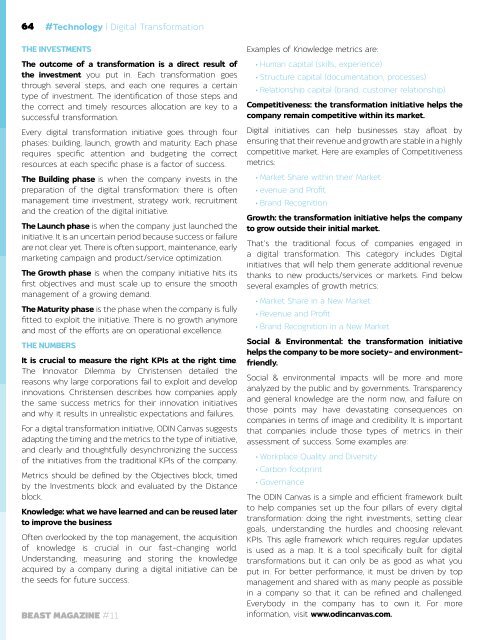Magazine_BEAST_2018_Edition_11_complet.compressed
You also want an ePaper? Increase the reach of your titles
YUMPU automatically turns print PDFs into web optimized ePapers that Google loves.
64<br />
#Technology | Digital Transformation<br />
THE INVESTMENTS<br />
The outcome of a transformation is a direct result of<br />
the investment you put in. Each transformation goes<br />
through several steps, and each one requires a certain<br />
type of investment. The identification of those steps and<br />
the correct and timely resources allocation are key to a<br />
successful transformation.<br />
Every digital transformation initiative goes through four<br />
phases: building, launch, growth and maturity. Each phase<br />
requires specific attention and budgeting the correct<br />
resources at each specific phase is a factor of success.<br />
The Building phase is when the company invests in the<br />
preparation of the digital transformation: there is often<br />
management time investment, strategy work, recruitment<br />
and the creation of the digital initiative.<br />
The Launch phase is when the company just launched the<br />
initiative. It is an uncertain period because success or failure<br />
are not clear yet. There is often support, maintenance, early<br />
marketing campaign and product/service optimization.<br />
The Growth phase is when the company initiative hits its<br />
first objectives and must scale up to ensure the smooth<br />
management of a growing demand.<br />
The Maturity phase is the phase when the company is fully<br />
fitted to exploit the initiative. There is no growth anymore<br />
and most of the efforts are on operational excellence.<br />
THE NUMBERS<br />
It is crucial to measure the right KPIs at the right time.<br />
The Innovator Dilemma by Christensen detailed the<br />
reasons why large corporations fail to exploit and develop<br />
innovations. Christensen describes how companies apply<br />
the same success metrics for their innovation initiatives<br />
and why it results in unrealistic expectations and failures.<br />
For a digital transformation initiative, ODIN Canvas suggests<br />
adapting the timing and the metrics to the type of initiative,<br />
and clearly and thoughtfully desynchronizing the success<br />
of the initiatives from the traditional KPIs of the company.<br />
Metrics should be defined by the Objectives block, timed<br />
by the Investments block and evaluated by the Distance<br />
block.<br />
Knowledge: what we have learned and can be reused later<br />
to improve the business<br />
Often overlooked by the top management, the acquisition<br />
of knowledge is crucial in our fast-changing world.<br />
Understanding, measuring and storing the knowledge<br />
acquired by a company during a digital initiative can be<br />
the seeds for future success.<br />
<strong>BEAST</strong> MAGAZINE #<strong>11</strong><br />
Examples of Knowledge metrics are:<br />
• Human capital (skills, experience)<br />
• Structure capital (documentation, processes)<br />
• Relationship capital (brand, customer relationship)<br />
Competitiveness: the transformation initiative helps the<br />
company remain competitive within its market.<br />
Digital initiatives can help businesses stay afloat by<br />
ensuring that their revenue and growth are stable in a highly<br />
competitive market. Here are examples of Competitiveness<br />
metrics:<br />
• Market Share within their Market<br />
• evenue and Profit<br />
• Brand Recognition<br />
Growth: the transformation initiative helps the company<br />
to grow outside their initial market.<br />
That’s the traditional focus of companies engaged in<br />
a digital transformation. This category includes Digital<br />
initiatives that will help them generate additional revenue<br />
thanks to new products/services or markets. Find below<br />
several examples of growth metrics:<br />
• Market Share in a New Market<br />
• Revenue and Profit<br />
• Brand Recognition in a New Market<br />
Social & Environmental: the transformation initiative<br />
helps the company to be more society- and environmentfriendly.<br />
Social & environmental impacts will be more and more<br />
analyzed by the public and by governments. Transparency<br />
and general knowledge are the norm now, and failure on<br />
those points may have devastating consequences on<br />
companies in terms of image and credibility. It is important<br />
that companies include those types of metrics in their<br />
assessment of success. Some examples are:<br />
• Workplace Quality and Diversity<br />
• Carbon footprint<br />
• Governance<br />
The ODIN Canvas is a simple and efficient framework built<br />
to help companies set up the four pillars of every digital<br />
transformation: doing the right investments, setting clear<br />
goals, understanding the hurdles and choosing relevant<br />
KPIs. This agile framework which requires regular updates<br />
is used as a map. It is a tool specifically built for digital<br />
transformations but it can only be as good as what you<br />
put in. For better performance, it must be driven by top<br />
management and shared with as many people as possible<br />
in a company so that it can be refined and challenged.<br />
Everybody in the company has to own it. For more<br />
information, visit www.odincanvas.com.

















